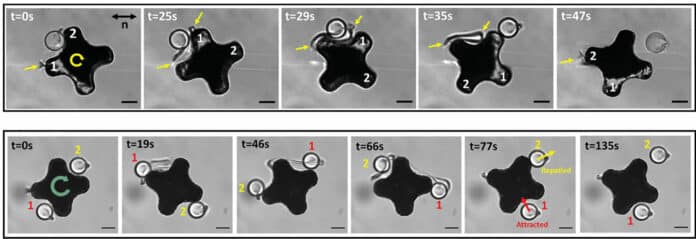Controlling microscopic processes is inherently challenging. The everyday tool used to manipulate matter on the macroscale can’t simply be shrunk down to the size of the cell, and even if they could, the physical forces they rely on work differently when their targets are measured in nanometers.
Now, Penn engineers are working to make controlling microscopic processes, such as transporting drugs to tumors for precise therapies, faster, safer, and more reliable through the use of microrobots.
Untethered mobile microrobots are the focus of intensive research with diverse strategies for actuation, mobility, and interaction. However, programming a machine smaller than a microchip presents another kind of challenge. Robots on this scale need to be designed in a completely different way than their bigger counterparts.
Since they are too small for their own onboard computers, Microrobots move about by means of an external magnetic force. To manipulate equally small cargo, these tiny robots need to take advantage of the different physical and chemical laws that rule the microscale.
At those sizes, every object is greatly influenced by the molecules surrounding it. Whether they are surrounded by gas, like the ambient atmosphere, or immersed in a liquid, microrobots must be designed to exploit this influence through a concept known as “physical intelligence.”
In their study, the research team describes a four-armed, magnetically controlled microrobot that can swim, carry cargo and actively restructure particles in this complex fluid. Being able to manipulate processes on this level is groundbreaking. Also, understanding how robotic systems are able to perform tasks in an indirect way, considering the fluid dynamics and physical interactions of the media as a part of the microrobot’s design, is key.
“Using physics of nematic liquid crystals,” says Tianyi Yao, the lead author of both studies, “we can build physically intelligent microrobotic systems. We can make long-range interactions, tune binding strengths and reconfigure the space. While we have proven these interactions on the microscale, the prevailing physics are also effective on very small scales, on the order of 30–50 nanometers.”
The team envisions real-world applications for this technology in the optical device industry, as well as many other fields. Smart materials, aware of their environment, may be designed using temperature and light as controls for microrobotic tasks.
Journal reference:
- Tianyi Yao, Žiga Kos, Qi Xing Zhang, Yimin Luo, Francesca Serra, Edward B. Steager, Miha Ravnik, and Kathleen J. Stebe. Nematic Colloidal Micro-Robots as Physically Intelligent Systems. Advanced Functional Materials, 2022; DOI: 10.1002/adfm.202205546
